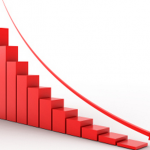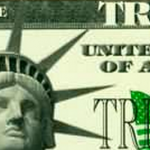In Part I, we identified the mammoth bond offering by Apple, Inc. (AAPL) at the end of April of this year as a seminal, watershed event within the history of the company. We proceeded to recount the developments that put CEO Tim Cook and AAPL in the crosshairs of Wall Street and the media… forcing their hand into making a major decision. As we continue our story, we will try to unfold for you the details of this new AAPL strategy and offer some details that will help you determine for yourself whether the plan makes sense for now and for AAPL’s future.
Following David Einhorn’s public “calling out” of Tim Cook and AAPL to take a bold step toward unlocking shareholder value through the maximization of its hoard of cash (about $145 billion), we waited anxiously for an announcement of AAPL’s response. No one I knew actually expected what we soon got! AAPL announced the run out of a huge, splashy new product … a $17 billion product, no less! The new product was the “i-BOND”! (Pardon the author for taking poetic liberties here… you’ll soon understand!)
Tim Cook announced a bold plan to return $100 billion to shareholders through a dividend increase (to a current yield of 2.7%) and an ongoing program of buying back common shares. Although this plan did not resemble Einhorn’s preferred share plan, even Einhorn was dully impressed (recent disclosures by his Greenlight Capital fund reveal that Einhorn increased his AAPL holdings during the quarter!).
The financial neophyte would likely expect AAPL to parse out this three year $100 billion program to unlock shareholder value by using some of that $145 billion of cash on hand, as well as the annual cash generation of its businesses (over $50 billion in 2012) to cover the dividend and buybacks, with plenty to spare. But AAPL taught us a lesson on why we are neophytes and they are as creative in finance as Steve Jobs was with design, marketing, and technology!
Get a look at this quick summary of various analyses of the i–BOND , including this one from Seeking Alpha (http://seekingalpha.com/article/1412911-apple-a-deep-dive-into-perhaps-the-most-profitable-bond-issue-ever?source=google_news):
1) During the first three years of this bond plan, the only cash outlay for AAPL is the interest owed on the various bonds.
2) The pre-tax cost to AAPL is irrelevant, since it is the after-tax cost that impacts AAPL’s financial performance. Note that tax is a significant element in the AAPL picture, since it paid $6 billion in tax during 2012 ($16.5 million/day… yes, that is correct!).
3) Assuming a 35% corporate tax rate… the after-tax cost to AAPL for the $3 billion in 30-year bonds is a mere 2.5% — or $75 million per year. [1]
4) More starkly, the aggregate after-tax cost to AAPL of the entire i-BOND plan is around 1.25%… or (worst case) $375 million.
5) Even assuming their cash flow decreases a bit in future years (remember that it starts from $50 billion a year in 2012) it is safe to assume AAPL can “afford” the annual cost of servicing the debt.
6) However, most importantly, as AAPL buys shares back between now and 2015 (and one presumes beyond 2015), AAPL frees itself from the obligation to pay the holders of those shares the 2.75% annual dividend!!
7) Hmmm. The total after-tax cost is about 1.25%… helping to retire (share buyback by share buyback) AAPL’s obligation to pay a 2.75% dividend. Is this a great plan or what?!
8) Assuming that AAPL continues buying back shares for thirty years, here is one view of its cumulative savings:
The Graph above is from http://seekingalpha.com/article/1412911-apple-a-deep-dive-into-perhaps-the-most-profitable-bond-issue-ever?source=google_news
1) If AAPL increases the dividend by 3% per year, the savings can rise exponentially:
The Graph above is from http://seekingalpha.com/article/1412911-apple-a-deep-dive-into-perhaps-the-most-profitable-bond-issue-ever?source=google_news
1) With apologies in advance to all mathematicians and chartered financial analysts (because I know this quick review is obscenely simplistic) whether or not the claim of this analyst is fully correct, the following summary does suggest to us the general sense of whether this i-BOND plan is a financial plus: (bold font added by me) “assuming a 3% dividend raise yearly means Apple could save as much as $23 billion. If this were to occur, it would mean Apple was investing less than $4 billion in order to profit $23 billion over thirty years.” – Josh Arnold, Seeking Alpha http://seekingalpha.com/article/1412911-apple-a-deep-dive-into-perhaps-the-most-profitable-bond-issue-ever?source=google_news
At this point you might be thinking – “Wow, this i-BOND product is pretty amazing. Let’s do more!”
I understand, readers. But take a deep breath and get ready for this, because this piece of the puzzle makes the i-BOND not only a creation of genius, but also fairly essential in light of the “nature” of AAPL’s cash!
Now you are thinking: “But Tom, “cash’ is ‘cash’. It can come in different bill sizes (George Washington versus Andrew Jackson versus Woodrow Wilson (great trivia question, by the way; see the image below). But ‘cash’ is ‘cash’!”
My response is this: “’Cash’ is ‘cash’ unless it is cash earned overseas and still sitting overseas. Then it is cash that needs to be ‘repatriated’ – which will cost the company that owns that cash a high ransom in taxes (note that presumably, the cash has already been subject to foreign taxes)!
It is estimated that about $100 billion of AAPL’s $145 billion cash hoard is sitting overseas. Among technology companies with major international sales, that is not unusual.
PIE GRAPH to the left compares the amount of AAPL’s no cost domestic cash with its “costly” cash sitting overseas. (Credit: the author, created with Excel)
Companies such as Google (GOOG), Microsoft (MSFT), and AAPL hold as much as $1 trillion of the total $3 trillion in cash held by U.S. – and they hold so much in cash in large part because of the high cost of bringing “cash” back from overseas. That “high cost” can be quantified with regard to AAPL’s overseas cash pile; Moody’s Investment Services estimate that AAPL has saved $9.2 billion by not feeling compelled to repatriate that overseas cash to cover this dividend/share buyback program. Gerald Granovsky, senior vice president at Moody’s, proved himself as a master of understatement when he called AAPL’s i-BOND plan a “no-brainer.”
We already know that financially, the i-Bond program is a huge “home run” for AAPL. However, just like they say in the late night TV commercials for mail order products: “But wait….there is MORE!” The i-BOND plan makes AAPL an ironclad “dividend stock” for years to come. As we pointed out from the start, professional fund managers of all types are obligated to adhere to the investment policy statement (ISP) assigned to their fund – which offers a benchmark for them to target and often identifies certain financial metrics and characteristics by which the manager must filter stock selections for the portfolio.
We’ve already witnessed how quickly growth managers “throw stocks under the bus” (as they did with AAPL). Managers whose ISP has an “income tilt” tend to be more forgiving, more tolerant, and more patient with a stock, as long as the company’s financials demonstrate that the dividend is secure. On that basis, as the “growth managers” were casting AAPL right in front of a big Greyhound bus (driving the stock down 45%) the stock became increasingly appealing for income managers.
Income managers became even more intrigued when Einhorn made public his elaborate proposal to “unlock shareholder value”. AAPL definitely had their attention. At that point, the $100 billion plan to increase the dividend to 2.7% and buy back shares between now and 2015 “sealed the deal” for the income managers. That yield is almost half again higher than the average yield of the S&P 500 Index (1.93%) and places AAPL 16th highest within the Dow Jones Industrial Average (were it to replace Hewlett Packard (HP)). Therefore, while the growth managers kept unloading AAPL… millions of shares were picked up by the income in managers – a process of “churning” that was interesting to witness.
Finally, if all of this was not enough to get you excited about the power of i-BONDS to accomplish the following:
1) drive firmer, more loyal institutional demand;
2) produce a new, intermediate-term “profit stream”;
3) create a healthy dividend to ensure more dependable “total return” (at least on a relative basis);
4) provide a simple, effective way to “unlock” $100 billion in problematic foreign cash (“problematic” because of its high tax cost);
there is at least one more “bonus” benefit! As AAPL proceeds to buyback shares, it reduces the “shares outstanding”, thereby improving all the popular “per share” metrics of performance (Earnings/Share; Revenue/Share, Book Value/Share, etc.). The effective result of this “per share” performance boost is to ensure a happier “Wall Street” when AAPL unfolds future quarterly earnings reports!
The bottom line is this. Tim Cook is no Steve Jobs – not even close. But given the limitations within which Cook operates, I believe that Tim has “pulled a rabbit out of the hat” with the i-BOND plan. Yes, Steve Jobs may be rolling over in his grave a bit (more about that later). However, if one accepts the premise that AAPL had to do something bold in the absence of any shiny, new, breathtaking hardware product – even Steve Jobs would have to give Tim Cook credit for an extremely creative, effective, profitable new “product” (the i-BOND) through which to bring a different kind of excitement into Apple, Inc. and its stock!
Submitted by Thomas Petty
Related Posts
Also on Market Tamer…
Follow Us on Facebook

 Should You Buy Tractor Supply Stock Right Now?
Should You Buy Tractor Supply Stock Right Now?



